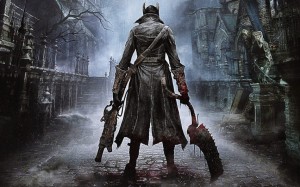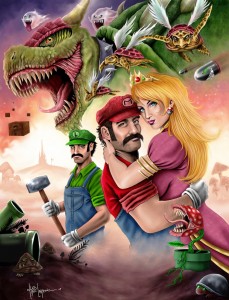Excuse me, regular reader, because this week I am going to bring up the Souls series again. Often I find myself looking to this series as an example for my topics and usually I find a way to avoid mentioning it on the grounds that I have done so quite a bit in the past on this site. But I think this time around the series fits too well to look elsewhere in my personal gaming exploits for examples. That is because this week I wish to touch on a concept much bigger than videogames and yet a considerable part of them. Myth building is a term I claim no ownership of nor expertise in, but nevertheless is a fascination of mine. As I know it, it is the building up of story and structure from around an originally much simpler, often archetypical, scenario. These scenarios are often simple out of necessity and in the realm of videogames it was both because of technological limitations interfering with exposition and the perceived demand for complex stories.
An easy example might be the Mario series which, while still quite simple today, began as something even more rudimentary. The idea that Bowser steals Peach (originally Princess Toadstool) turned from an excuse to play the game, to a plot point, to a trope and then into something closer to a force of nature to be expected in the Mario universe. A need for earlier boss encounters spawned the idea of the Koopalings, and even the need for a distinct second player spawned the idea of a brother for Mario whose personality would come to embody the submissive Second Fiddle. These enrichments to the Mario world were fitted into the originally present gameplay mechanics (parts of the so called “ludonarrative”) and built upon as those mechanics became staples. It would seem an almost backward manner of creating a story if it were not for how common it is in games and the similar nature of cultural myths and legends.
This brings me to the Souls series because of the intriguing embrace of this exact manner of myth building present in the first two games. Original series director Hidetaka Miyazaki took inspiration for the plot and setting of the series from Western texts he was unable to fully comprehend in English. In the absence of information, he filled in the blanks on his own and felt the process uniquely rewarding despite not being true to the texts. The nature of this kind of individual story discovery deeply informed the way the Souls series characteristically kept exposition to a minimum. Most of the intrigue was fed to players in drips and drabs and in rather atypical ways. Item descriptions would divulge major plot points about locales or primary figures, with little of the plot being discussed in the present by NPCs and without the crutch of boring info dumps like journals or audio logs. Many times the locations and the action in them spoke for themselves, and when they left questions unanswered it was generally up to the player to make conclusions.

Bloodborne promises to carry on the less-is-more approach to story telling Miyazaki began with Demon’s Souls.
Being primarily an action game and a deceptively linear one, plot points are not necessary to figure out how to progress the game. They are, however, rewarding when a particularly difficult encounter is given more context. The myth building in the Souls series, this concept which I admittedly feel challenged to frame properly, is impinged upon the player in a manner I cannot draw any parallels to in modern gaming. Ordinarily, as with the Mario games mentioned above, the initial concepts are expanded upon by turning them into constants or staples of the series. But even Dark Souls 2 was more hands-off than not when it came to story and, despite not being headed by the same director (he did fulfill a supervisory role), it kept the story at arms length from the player.
This concept folds into another topic I had brewing for months but never really broached, of the increasing venerability of things as they simply age. As a game or concept in a game gets older it tends to be looked upon only more and more favorably, with even small cult hits growing in power as time goes on and nostalgia builds the game up. Some things are almost* universally shunned, of course, like Survival Horror tank controls. But the rising popularity is similar in some ways to the myth building done by creators to flesh out their game worlds, as nostalgia builds up things once culturally miniscule (Beyond Good and Evil?) into a massive thing placed on a pedestal. A bit of a disparate concept, and probably why I did not give it its own article, but I think it plays into the desire by game creators to build up their old games into legends. Mario and Link in the Nintendo stables both have cemented their images and bring with them a great deal of built up baggage, to put it negatively, whereas earlier in their existence Mario and Link were involved in very divergent things. Mario 2 and The Adventures of Link were both massive departures the likes probably not to be seen again thanks in part to the built up images of these characters Nintendo is adverse to go against.
In all it makes for some unusual story telling methods, but ones that are no less charming or endearing. Newer game franchises are made from the ground up often with serialization in mind and so the plots and characters in them are often fully fleshed out. The medium has moved away from the days where exposition was too much to ask and into an era where it might even be pushing the boundaries of the definition of the word “game”. Examples like Mario and curiosities like Miyazaki’s Souls series (soon to include Bloodborne) are probably only going to dwindle in number as AAA game development continues to seek out Hollywood for inspiration.
So tell me if you followed any of this, adamant reader. I cannot say I entirely blame you if you do not. The idea of a simple story blossoming into something much bigger than it once was is an old part of videogames that I wonder if we will see it return. Indies may yet do so, if their avenues for publication remain open. If you can think of any other examples of games with initially simplistic game stories built up into a massive mythos, share them below (I left off a few pretty obvious ones).
